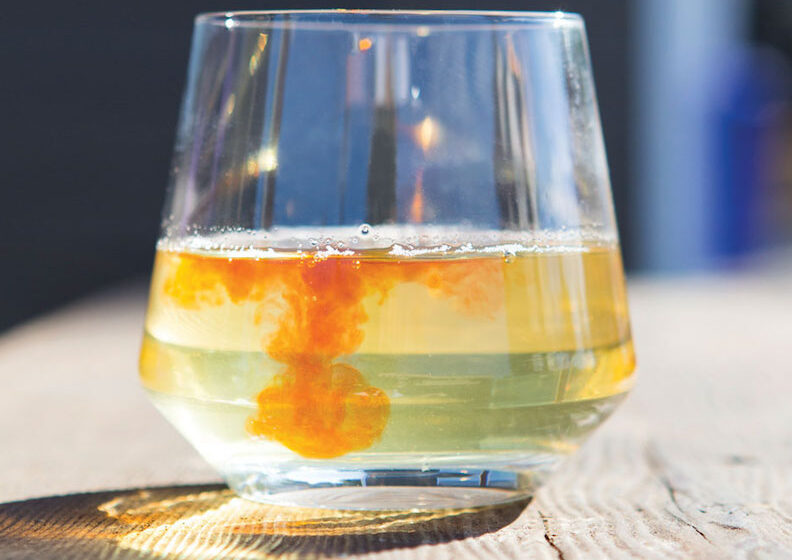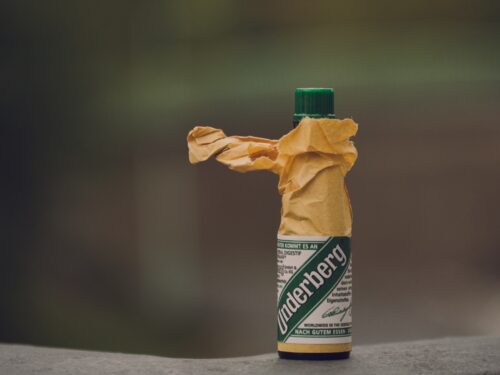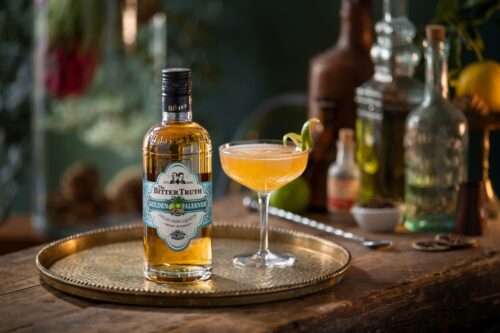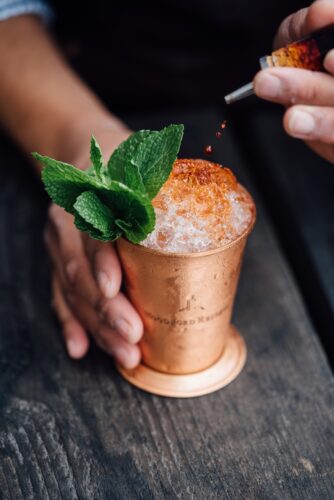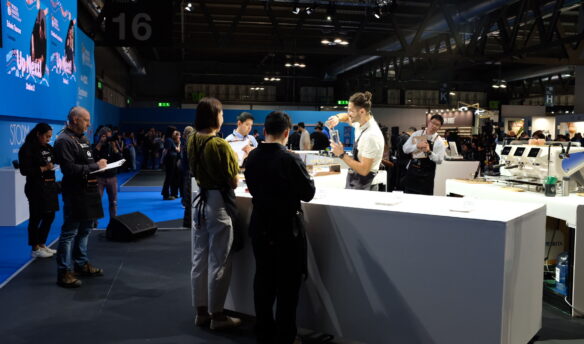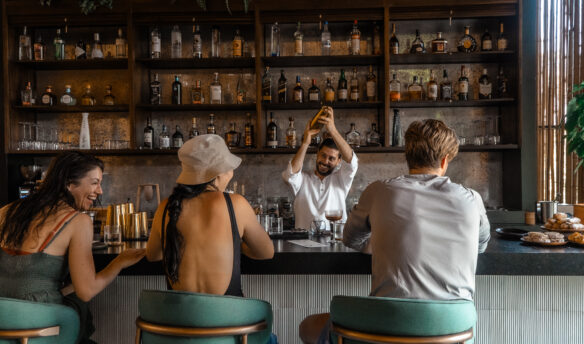In a café, bitterness is generally undesirable. To oversimplify: with coffee, bitterness often indicates over-extraction or excessive roasting.
With tea, bitterness can mean that the brew time was too long or the water was too hot. Biologically, bitterness in food can be a natural indicator of poison. But when implemented smartly, bitterness can be your friend. The element of bitterness can add tremendous depth to specialty drinks.
What’s the best, easiest, and most effective way to add bitterness to your beverages? Bitters.
Bitters are various bitter materials—gentian root, quassia bark, and cinchona bark—extracted in alcohol and flavored with aromatic ingredients such as orange peel, cardamom, lavender, hops, and even coffee. Though the practice of infusing wine with bitter herbs can be traced back to ancient Egypt, you’ll want to use the more modern, concentrated varieties: cocktail or tincture bitters.
Initially used for their medicinal benefits, these patent medicines became a versatile ingredient in the 19th century, used in small dashes, essential to the original “cocktail,” or what we know as an Old Fashioned. Countless classic and modern cocktails exist because of bitters. If they are indispensable to bartenders, why not baristas?
Jump On The Bitter Train
How do you get started experimenting with bitters? First: buy some bitters.
Many commercially available bitters contain around forty to fifty percent alcohol by volume. Most are classified as non-potable (meaning you wouldn’t chug a bottle on its own as it’s not intended to be sipped on or drank alone) food products, similar to other flavor concentrates like vanilla extract. Bitters generally can be found at cocktail gear shops and high-end grocers—even places that don’t sell liquor. If they are non-potable, you don’t need a liquor license to use them in a café.
There are dozens of bitters manufacturers making myriad flavors, so it’s easy to branch out beyond the ubiquitous Angostura bitters. My café’s go-to brand, Scrappy’s, hand makes many excellent flavors, from grapefruit to chocolate. You should only need a couple of varieties to begin with, but if you’re like me, you might as well designate an entire shelf for bitters. You’ll see.
Not only do bitters add elements of bitterness, spice, and aroma, they can also enhance subtle flavors in other ingredients and help disparate elements mingle nicely.
A Bitter Menu Option
Next, put bitters in everything. Seriously. Put a dash of bitters in every drink on your menu—even the hot ones. If it’s disgusting, move on to the next drink. If it’s interesting, add another dash, add something sweet or sour, or try a different kind of bitters. Bitters are like seasoning for drinks. Not only do they add elements of bitterness, spice, and aroma, they can enhance subtle flavors in other ingredients and can help disparate elements mingle nicely.
When I started implementing bitters into my menu, our existing tea lattes provided an easy platform for experimentation. Bright red Peychaud’s fit perfectly in the subtle Black Rose Tea Latte (rose Ceylon, rose petals, vanilla syrup, and steamed milk), which was already on our menu. Its aromatics kept the drink from smelling too perfume-like, and its bitterness and spice provided a deeper, more complex rose flavor. Try obvious combinations, such as orange bitters and chocolate, or combine things that shouldn’t work—like espresso, parsley oil, and grapefruit bitters—and you might be surprised.
Soon enough, bitters and bitterness will become essential to your drink development. I put bitters into every single drink I develop. Sometimes the bitters seem imposing and are omitted, but most of the time, they complete the drink.
Finding Balance
Toward the end of summer, Utah’s High Desert Gold Honey Co. owner gave me a bucket of raw, local honey, and I wanted to showcase it in one last summery drink. I created a two-part drink called Black & Gold: the black was represented by the espresso served in a shot glass; the gold was a short honey soda flavored with a bit of coffee and lavender bitters.
On its own, the soda was too sweet. When paired with an espresso, the espresso’s inherent bitterness countered the soda’s sweetness both by comparison and by bringing out the bitterness of the coffee and lavender bitters, making the soda much more balanced and complex. The Black & Gold would have tasted only like honey and flowers without bitterness.
Aside from using bitters to enhance or balance, one can make tasty beverages in which bitterness is the primary element. Amari, or bitter Italian herbal liqueurs, are so named because of this trait—amaro means bitter in Italian. Campari and Fernet Branca are popular examples.
The Negroni cocktail, made with Campari, is a prime example of a drink built around bitterness. Amari are typically grain-alcohol based, but unlike tincture bitters, they’re meant to be drunk neat or mixed into cocktails in larger portions. They’re potable, so unless your café has the proper liquor license, you can’t start throwing them into drinks or making your own.
You can, however, do what I did: make a tea or coffee–based version. Some of the more obscure ingredients, like gentian root, can be found online. Below is a recipe for the Alba Milano, my tea-based version of an amaro and soda. For someone unaccustomed to bitterness, a drink like this may be shocking. If you embrace the bitterness, you’ll soon find it indispensable.
Alba Milano
2 g juniper berries (crushed)
5 g gentian root
2 g wild cherry bark
2 g anise seed
750 mL water
10 g Art of Tea Green Earl Grey
15 g Art of Tea Hibiscus Cooler blend
500 g turbinado sugar
Combine all ingredients except for the Green Earl Grey, the Hibiscus Cooler, and the sugar in a medium saucepan and bring to a boil. Simmer uncovered for thirty minutes.
After thirty minutes:
- Add the Green Earl Grey, Hibiscus Cooler, and turbinado sugar.
- Stir the sugar until it’s dissolved, then simmer for five minutes.
- Pour the liquid through a fine mesh strainer lined with cheesecloth into a heat-resistant container.
This recipe yields about 750 mL, so after it has cooled, decant into an empty 750 mL bottle for ease of use. Keep it refrigerated and use it within two weeks.
Cody Kirkland is the bar manager at The Rose Establishment in Salt Lake City.
This story was originally published on October 28, 2015 and has been updated to meet Fresh Cup’s current editorial standards.


